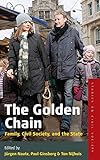The Golden Chain : Family, Civil Society and the State / ed. by Jürgen Nautz, Ton Nijhuis, Paul Ginsborg.
Material type: TextSeries: Studies on Civil Society ; 6Publisher: New York ; Oxford : Berghahn Books, [2013]Copyright date: ©2013Description: 1 online resource (324 p.)Content type:
TextSeries: Studies on Civil Society ; 6Publisher: New York ; Oxford : Berghahn Books, [2013]Copyright date: ©2013Description: 1 online resource (324 p.)Content type: - 9780857454706
- 9780857454713
- 306 23/eng
- HQ503
- online - DeGruyter
| Item type | Current library | Call number | URL | Status | Notes | Barcode | |
|---|---|---|---|---|---|---|---|
 eBook
eBook
|
Biblioteca "Angelicum" Pont. Univ. S.Tommaso d'Aquino Nuvola online | online - DeGruyter (Browse shelf(Opens below)) | Online access | Not for loan (Accesso limitato) | Accesso per gli utenti autorizzati / Access for authorized users | (dgr)9780857454713 |
Frontmatter -- CONTENTS -- LIST OF FIGURES AND TABLES -- ACKNOWLEDGEMENTS -- EDITORS’ PREFACE -- PART I Introduction and Overview -- INTRODUCTION -- Chapter 1 UNCHARTED TERRITORIES: INDIVIDUALS, FAMILIES, CIVIL SOCIETY AND THE DEMOCRATIC STATE -- PART II Feminist Historical Views -- Chapter 2 GENDERED BOUNDARIES: CIVIL SOCIETY, THE PUBLIC/PRIVATE DIVIDE AND THE FAMILY -- Chapter 3 THE FAMILY, CIVIL SOCIETY AND SOCIAL POLICY A US PERSPECTIVE -- Chapter 4 FEMINIST MOBILISATION AND FAMILY CHANGE: A CASE STUDY OF A GRASSROOTS WOMEN’S ORGANISATION IN QUEBEC: THE AFEAS (1966–1989) -- Part III Family and Society in South and Western Europe: Case Studies -- Chapter 5 Corporate Birthmarks of Civil Society: Kinship and Kinship Networks in Voluntary Associations, 1800–1848 -- Chapter 6 STATE, SOCIETY AND FAMILY CHANGE IN TWENTIETH-CENTURY SPAIN THE EVOLUTION OF THE ‘STRONG FAMILY MODEL’ -- Chapter 7 THE FOUNDATION OF CIVILISED SOCIETY: FAMILY AND SOCIAL POLICY IN BRITAIN AND ITALY BETWEEN 1946 AND 1960 -- Chapter 8 CHILDREN AND CIVIL SOCIETY -- PART IV State and Changing Families in Eastern Europe and the Middle East -- Chapter 9 THE FAILURES OF MODERNITY: FAMILY, CIVIL SOCIETY AND STATE IN THE PASSAGE FROM OTTOMAN EMPIRE TO TURKISH REPUBLIC -- Chapter 10 ISRAEL AND PALESTINE THROUGH FAMILY, CIVIL SOCIETY AND STATE AN OVERVIEW -- Chapter 11 GENDERED BOUNDARIES BETWEEN THE STATE, FAMILY AND CIVIL SOCIETY THE CASE OF POLAND AFTER 1989 -- Chapter 12 FAMILY STRUCTURES AND CIVIL SOCIETY PERSPECTIVES IN PRESENT-DAY SERBIA -- NOTES ON CONTRIBUTORS -- INDEX
restricted access online access with authorization star
http://purl.org/coar/access_right/c_16ec
The family can be viewed as one of the links in a “golden chain” connecting individuals, the private sphere, civil society, and the democratic state; as potentially an important source of energy for social activity; and as the primary institution that socializes and diffuses the values and norms that are of fundamental importance for civil society. Yet much of the literature on civil society pays very little attention to the complex relations between civil society and the family. These two spheres constitute a central element in democratic development and culture and form a counterweight to some of the most distressing aspects of modernity, such as the excessive privatization of home life and the unceasing work-and-spend routines. This volume offers historical perspectives on the role of families and their members in the processes of a liberal and democratic civil society, the question of boundaries and intersections of the private and public domains, and the interventions of state institutions.
Mode of access: Internet via World Wide Web.
In English.
Description based on online resource; title from PDF title page (publisher's Web site, viewed 25. Jun 2024)


